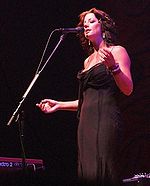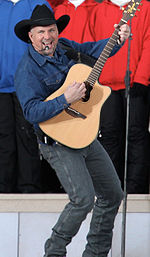- Music history of the United States in the 1990s
-
History of the United States Military - Postal - Diplomatic - Expansionist - Religious - Industrial - Feminist - Music Music of the United States Colonial era - to the Civil War - During the Civil War - Late 19th century - Early 20th century - 40s and 50s - 60s - 70s - 80s - 90s - 2000s - 2010s Ethnic music Native American: Arapaho music, Blackfoot music, Inuit music, Iroquois music, Kiowa music, Navajo music, Pueblo music, Seminole music, Sioux music, and Yuman music - English: old-time and Western music - African American - Irish and Scottish - Latin: Tejano and Puerto Rican - Cajun and Creole - Hawaii - Other immigrants United States Popular music of the United States in the 1990s saw, in the beginning of the decade, formulaic metal bands which dominated the charts until 1991, saw a decline as G Funk gangsta rap, led by Dr. Dre, and Seattle-born grunge, led by Nirvana, knocked metal off the charts. Both genres were full of energy at the beginning of the decade, with grunge reacting against the perceived superficiality of recent rock trends, and Dr. Dre's Death Row Records stable of artists proudly placing the West Coast on the hip hop map. Both genres died out, however, both in the matter of the few years later in the decade. In its place arose a variety of brief, minor trends that failed to catch on. In rock, third wave of ska and pop punk bands, British techno music, funk metal, nu metal, riot grrl, alternative rock and industrial rock achieved sporadic success. Hip hop saw the East Coast reassert its primacy, and other cities, including Atlanta, Saint Louis, Detroit and New Orleans became major centers of commercial hip hop. Alternative hip hop also flourished into the next millennium, when it accompanied the much-hyped garage rock revival and a massive pop interest in teen idol boy bands and divas, many with a Latin flourish.
Contents
Rock
Alternative rock
 Red Hot Chili Peppers, 1991
Red Hot Chili Peppers, 1991
With the breakthrough of Nirvana and the popularity of the grunge and Britpop movements in the 1990s, alternative rock entered the musical mainstream and many alternative bands became commercially successful during the 1990s.
By the start of the 1990s, the music industry was enticed by alternative rock's commercial possibilities and major labels actively courted bands including Jane's Addiction, Dinosaur Jr, Firehouse, and Nirvana.[1] In particular, R.E.M.'s success had become a blueprint for many alternative bands in the late 1980s and 1990s to follow; the group had outlasted many of its contemporaries and by the 1990s had become one of the most popular bands in the world.[2]
The Red Hot Chili Peppers became an important band in the rise of alternative rock with their album Blood Sugar Sex Magik bringing worldwide attention to alternative rock. Combining funk rock with more conventional rock, the Chili Peppers were able to achieve mainstream success climaxing with the release of Californication.
Some of the top mainstream American Alternative Rock bands of 1990s included Alice in Chains, Red Hot Chili Peppers, R.E.M., Live, Counting Crows, Goo Goo Dolls, Third Eye Blind, The Smashing Pumpkins, Beck, Sublime, Hole (band), Blind Melon and Pearl Jam.
Grunge
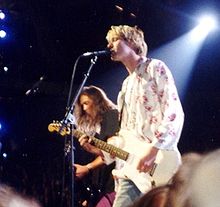 Nirvana is considered to have brought both grunge and alternative rock to the mainstream in late 1991
Nirvana is considered to have brought both grunge and alternative rock to the mainstream in late 1991
A sub-genre of alternative rock, grunge bands picked up popularity for the early 1990s. Early notable grunge bands included among others Alice in Chains, Mudhoney and Soundgarden.
Grunge remained a mostly local phenomenon until the breakthrough of Nirvana in 1991 with their album Nevermind which also lead to the widespread popularization of Alternative rock in the 1990s. Nirvana was an instant sensation worldwide propelled by their massive hit "Smells Like Teen Spirit". Nirvana's surprise success with Nevermind heralded a "new openness to alternative rock" among commercial radio stations and opened the doors for heavier alternative bands in particular.[3] In the wake of Nevermind, record companies whom were eager to capitalize on the genre's success, started to sign alternative rock artists.[4] The meaning of the term "alternative" changed as mainstream success attracted major-label investment and commercially-oriented or manufactured acts with a formulaic, conservative approach. With this, "alternative" lost its original counter-cultural meaning and began to refer to the new form of music that was now achieving mainstream success.
Nirvana whetted the public's appetite for more direct, less polished rock music, and one place it was found was in the debut album from a hard-rocking West Coast band with ties to the grunge movement, a band named Pearl Jam. Pearl Jam took a somewhat more traditional rock approach than other grunge bands but shared their passion and rawness. Pearl Jam had released its debut album Ten a month before Nevermind in 1991, but album sales only picked up a year later. By the second half of 1992 Ten became a breakthrough success, being certified gold and reaching number two on the Billboard 200 album chart.[5]
During the mid-1990s many grunge bands broke up or became less visible. The death of Kurt Cobain in early 1994, as well as the touring problems for Pearl Jam (which happened due to the band's much-publicized boycott of Ticketmaster), marked the decline of the genre.[6]
Post-grunge
 Foo Fighters, 2007
Foo Fighters, 2007
The death of Kurt Cobain in early 1994, as well as touring problems for Pearl Jam, marked a decline for grunge that year.[6] At the same time major record labels began signing and promoting bands that were emulating the genre.[7] The term post-grunge was coined to describe these bands, who emulated the attitudes and music of grunge, particularly thick, distorted guitars, but with a more radio-friendly commercially-oriented sound.[6]
In 1995, former Nirvana drummer Dave Grohl's new band, the Foo Fighters, helped popularize the genre and define its parameters, becoming one of the most commercially successful rock bands in the US, aided by considerable airplay on MTV.[8]
Some post-grunge bands, like Candlebox, were from Seattle, but the sub-genre was marked by a broadening of the geographical base of grunge, with bands like Los Angeles' Audioslave(which included both members Rage Against The Machine, and vocalist Chris Cornell of Soundgarden who was no stranger to the seattle grunge movement) , and Georgia's Collective Soul and beyond the US to Australia's Silverchair and Britain's Bush, who all cemented post-grunge as one of the most commercially viable sub-genres of the late 1990s.[9][10]
Pop punk
Pop punk in the United States underwent a resurgence in the early to mid 1990s. Pop punk at that time was not commercially viable, and no major record label signed a pop punk band until Blink 182's breakthrough in 1997. Both these factors contributed to the emergence of a number of independent record labels, often run by people in bands in order to release their own music and that of their friends. The independent labels Lookout! Records, Fat Wreck Chords and Epitaph Records achieved commercial success after bands such as Green Day brought in a new audience for pop punk.
Pop punk broke into the mainstream in the mid-1990s, initially with the Northern California-based pop punk band Green Day and afterwords with the Southern California-based pop punk bands Blink-182 and The Offspring as well whom all achieved massive worldwide commercial success. Green Day's album Dookie (1994) sold 10 million copies in the United States and 20 million copies worldwide. Soon after the release of Dookie, The Offspring released the album Smash. The album sold over 14 million copies worldwide, setting a record for most albums sold on an independent label. Also in the spring of 1994, Weezer released its debut album, most commonly known as The Blue Album peaked at number 16 on the charts and revived heavy radio and MTV rotation[11] By the end of the year, Dookie and Smash had sold millions of copies.[12] The commercial success of these two albums attracted major label interest in pop punk, with bands such as Bad Religion being offered lucrative contracts to leave their independent record labels. In 1999, Blink-182 released Enema of the State, which sold over 15 million copies worldwide.
This genre remained popular in America through the rest of the 1990s and the entire 2000s.
Nu metal and rapcore
In the early 1990s, bands like Red Hot Chili Peppers, Rage Against the Machine, 311 and Cypress Hill had brought a fresh sound by combining rap and rock with much success. These bands laid down the blueprints of rap metal and rapcore. In the middle of the decade this style, which contained a mix of grunge, metal, and hip-hop, became known as nu metal. Korn and Limp Bizkit were early nu metal artists and their increasing popularity spawned a wave of successful bands like Linkin Park and P.O.D..
Indie rock
Following the immense success of Alternative rock in the 1990s, The term "Indie rock" became associated with the bands and genres that remained underground. Bands like Sonic Youth and The Pixies set the stage for the rise of indie rock in the underground scene, with bands such as Pavement and The Flaming Lips gaining popularity in the early years.
Soft rock and singer-songwriter
A revival of the singer-songwriter movement of the 1970s, closely connected to Third-wave feminism and the Lilith Fair, this movement lasted up to about 2002 with artists like Norah Jones and Sarah McLachlan. Important artists include Alanis Morissette, Tori Amos, Edwin McCain, Jewel, Natalie Merchant and Sheryl Crow. Perhaps the most important album of this movement was the many-times platinum Jagged Little Pill by Alanis Morissette.[13]
Also in the 1990s, artists such as Dave Matthews and Elliott Smith borrowed from the singer-songwriter tradition to create new acoustic-based rock styles.
Heavy metal
Many subgenres of heavy metal developed outside of the commercial mainstream during the 1980s.[14] In the early 1990s the Thrash metal genre achieved breakout success, mainly due to the massive success of Metallica's eponymous 5th album which was released in 1991 and brought thrash metal to the mainstream for the first time. Metallica's success was followed by Megadeth's Countdown to Extinction (1992) which hit number 2,[15] Anthrax and Slayer cracked the top 10,[16] and albums by regional bands such as Testament and Sepultura entered the top 100.[17]
In the later half of the decade Industrial Metal became popular. The top mainstream American Industrial Metal bands of 1990s included include Marilyn Manson, White Zombie, Nine Inch Nails, KMFDM, Ministry, and Fear Factory.
Other trends
Guns N' Roses, Metallica and Van Halen remained popular in the first half of the decade and while Aerosmith, Bon Jovi, Meat Loaf and U2 maintained their popularity throughout the entire decade.
Rap rock, rap metal, rapcore and Nu Metal all had their peak of success in the '90s with bands such as Rage Against the Machine, Korn, Limp Bizkit, Slipknot, and Disturbed.
By the late 1990s, mainstream interest in third wave ska bands such as The Mighty Mighty Bosstones and No Doubt waned as other music genres gained momentum.[18]
Pop
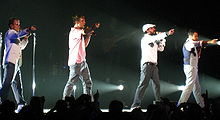 Vocal group, Backstreet Boys became one of the biggest boy bands of the 90s.
Vocal group, Backstreet Boys became one of the biggest boy bands of the 90s.
Contemporary R&B and urban pop began throughout the 1990s, but was replaced by more pop music and dance music by a short time in 1999.
Ballad songs were popular during this decade, popular American artists included Michael Bolton, Kenny G, Celine Dion, Mariah Carey, Whitney Houston, Bryan Adams, Gloria Estefan, Vanessa L. Williams, Shania Twain, LeAnn Rimes and Jennifer Paige.
Between 1997 and 1999 American teen pop singers and groups including Backstreet Boys (Although formed in 93 and released records before 97), *NSYNC, 98 Degrees, Hanson, Christina Aguilera, Britney Spears, Jennifer Lopez and Destiny's Child became popular. British girl group The "Spice Girls" manage to break America, becoming the most commercially successful British Group in North America since The Beatles. Their impact brings about a widespread invasion of female teen pop acts. At the end of the decade, Britney Spears and Christina Aguilera had huge successes with their hit singles, "...Baby One More Time" and "Genie In A Bottle" in 1999. The two continue to top the charts in the next decade.
Popular Pop music artists include Mariah Carey, Backstreet Boys, Salt-n-Pepa, Groove Theory, Boyz II Men, Bell Biv Devoe, Jodeci, Diana King, Tony! Toni! Tone!, Tara Kemp, 3T, Brownstone, Shanice, Paula Abdul, Usher, SWV, Aaliyah, Keith Sweat, R. Kelly, TLC, Brandy, Monica, Tevin Campbell, Maxi Priest, Shaggy and Toni Braxton.
Madonna's Erotica is released in 1992 and becomes one of her most controversial albums to date.
Contemporary R&B
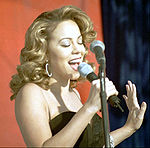 Mariah Carey is considered to be the biggest R&B act of the decade and the best-selling female artist of the decade.
Mariah Carey is considered to be the biggest R&B act of the decade and the best-selling female artist of the decade.
In the 1990s, Mariah Carey's career originated in quiet storm, with hit singles such as "Vision of Love" (1990), and "Love Takes Time" (1990) Also in the early 1990s, Whitney Houston's quiet storm hit included "All the Man That I Need" (1990) and "I Will Always Love You" (1992).[19] Richard J. Ripani wrote that Carey and Houston, "both of whom rely heavily on the gospel music vocal tradition, display an emphasis on melisma that increased in R&B generally over the 1980s and 1990s."[19] Carey's "Vision of Love" is considered to be an extreme example of the use of melisma.[19] Also during the early 1990s, Boyz II Men re-popularized classic soul-inspired vocal harmonies. Michael Jackson incorporated new jack swing into his 1991 album Dangerous, with sales over 32 million.[20][21]
In contrast to the works of Boyz II Men, Babyface and similar artists, other R&B artists from this same period began adding even more of a hip hop sound to their work. The synthesizer-heavy rhythm tracks of new jack swing was replaced by grittier East Coast hip hop-inspired backing tracks, resulting in a genre labeled hip hop soul by producer Sean Combs. The style became less popular by the end of the 1990s, but later experienced a resurgence.
During the mid 1990s, Janet Jackson, Mariah Carey, TLC, SWV and Boyz II Men brought contemporary R&B to the mainstream. Jackson's self-titled fifth studio album janet. (1993), which came after her historic multi-million dollar contract with Virgin Records, sold over ten million copies worldwide.[22][23] Boyz II Men and Carey recorded several Billboard Hot 100 #1 hits, including "Fantasy", "One Sweet Day", a collaboration between both acts, which became the longest-running #1 hit in Hot 100 history. Carey, Boyz II Men and TLC released albums in 1994 and 1995—Daydream, II , and CrazySexyCool respectively — that sold over ten million copies, earning them diamond and also making them the best selling female R&B group of all time. RIAA certification.
In the late 1990s, neo soul, which added 1970s soul influences to the hip hop soul blend, arose, led by artists such as D'Angelo, Erykah Badu, Lauryn Hill, and Maxwell. Hill and Missy Elliott further blurred the line between R&B and hip hop by recording both styles. Beginning in 1995, the Grammy Awards enacted the Grammy Award for Best R&B Album, with II by Boyz II Men becoming the first recipient. The award was later received by TLC for CrazySexyCool in 1996, Tony Rich for Words in 1997, Erykah Badu for Baduizm in 1998 and Lauryn Hill for The Miseducation of Lauryn Hill in 1999. At the end of 1999, Billboard magazine ranked Mariah Carey and Janet Jackson as the first and second most successful artists of the 1990s.[24]
Mariah Carey's duet with Boyz II Men "One Sweet Day" which was recorded in 1995 spent 16 weeks atop the Hot 100 and became the only single in history to do so, was pronounced song of the decade, charting at number one on the decade-end chart.
Hip hop
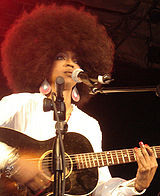 Lauryn Hill was one of the most successful Hip hop female artists of the 1990s.
Lauryn Hill was one of the most successful Hip hop female artists of the 1990s.
At the beginning of the 1990s, artists such as Public Enemy, Beastie Boys, Mc Hammer, Ice Cube, A Tribe Called Quest, Dr. Dre, Eazy-E, Snoop Dogg, Nas, Wu-Tang Clan continued to increase hip hop's visibility in the music mainstream. With the help of artists such as Fugees, 2Pac, and Notorious B.I.G., hip hop began to rival rock music with commercial sales and success by the mid-1990s.
In 1998, Lauryn Hill released her debut album The Miseducation of Lauryn Hill, which debuted at number one on the Billboard 200. In 1999, The Miseducation was nominated for 10 Grammy's, winning five (which at the time was unheard of for a hip-hop artist) and eventually went on to sell over 19 million copies worldwide.[25]
By the late 1990s, the style of hip hop had changed drastically from that of the early '90s. Most of the earlier hip hop cultural elements diminished, with business, money, and materialism being more of a focus. The overall sound changed drastically as well. Turntablism became less common in the mainstream, with synthesizers more often providing beats, giving a more polished sound. The traditional emcee lyrical forms and styles also changed. Story telling, and internal rhymes became less common, as well as many of the topics of early '90s lyrics, such as social issues, poverty, and history. By 1999, more 2000s styled glam started coming in, along with dirty south and crunk, with artists such as Mannie Fresh, Cam'ron, DMX, and Jay-Z.
The mid nineties were marked by the deaths of the West Coast-based rapper 2Pac and the East Coast-based rapper The Notorious B.I.G., which conspiracy theorists claim were killed as a result of the East Coast–West Coast hip hop rivalry.
Electronic music
 Moby, 2009
Moby, 2009
With the explosive growth of computers music technology and consequent reduction in the cost of equipment in the early 1990s, it became possible for a wider number of musicians to produce electronic music.
Even though initially most of the electronic music was dance music, the genre developed in the 1990s as musicians started producing music which was not necessarily designed for the dance-floor but rather for home listening (later on referred to as "Electronica") and slower paced music which was played throughout chillout rooms—the relaxation sections of the clubs (later on referred to as "Downtempo", "Chill-out music" and "Ambient music").
In the late 1990s Madonna had success with her album Ray of Light which experimented with electronica sounds. Moby achieved international success in the ambient electronica scene after releasing his critically acclaimed album Play in 1999 which produced an impressive eight hit singles (including his most popular songs "Porcelain", "Natural Blues" and "Why Does My Heart Feel So Bad?").
Electronic dance music was highly successful throughout the decade in Europe, particularly in Britain, Germany and Italy. Outdoor raves were popular at the start of the decade in the UK, before the government introduced its Criminal Justice and Public Order Act 1994, leading to a higher number of superclubs opening. Among the most successful were Ministry Of Sound and Cream. Before the ban, popular genres at these raves included Breakbeat Hardcore and techno, though in the mid-1990s these genres splintered into separate scenes, such as Happy Hardcore, Drum and Bass and Jungle, the latter of which received notable media attention in late 1994.
Other notable British genres that emerged during the decade include progressive house, big beat, Diva house, trip hop and UK Garage (or Speed Garage). The latter genre developed in London in the late 1990s and continued to be successful through to the early 2000s.
DJ Culture also gained momentum during the 1990s. DJs such as Sasha, John Digweed, Paul Oakenfold, Ferry Corsten and Pete Tong became big names in the business, which was made desirable by magazine such as Mixmag and Muzik.
Italy ended the 1980s with Italo House, before becoming one of many countries to release Eurodance and Hi-NRG. Both genres were commercially successful across the world, with artists such as 2 Unlimited, La Bouche and Captain Hollywood promoting the genre.
Countries such as Germany and Belgium, however, developed harder, darker styles of music, namely Gabber, Hard Trance and techno. Trance emerged in the early 1990s and by the end of the decade had penetrated most of Europe, with artists such as ATB, Ferry Corsten and Paul Van Dyk gaining huge commercial and underground success. European trance remained popular until the early 2000s.
Elsewhere in the world, Goa became famed for its Goa Trance parties and Ibiza became the Number 1 clubbers' holiday destination.
Country music
The popularity of country music exploded in the early 1990s. The stage had been set in 1989 with the debuts of several performers who proved to be profoundly influential on the genre during the 1990s and beyond. Most notable of that group was Garth Brooks, who shattered records for album sales and concert attendance throughout the decade. The RIAA has certified his recordings at a combined (128× platinum), denoting roughly 113 million U.S. shipments.[26] Brooks recorded primarily in a honky-tonk style, although he frequently combined elements of soft rock and arena rock in his songs. His songs sometimes explored social themes, such as domestic violence (in "The Thunder Rolls") and racial harmony ("We Shall Be Free)", while others — such as "Friends in Low Places" — were just good-time songs.
Other performers who rose in popularity during the early 1990s were neo-traditionalists Clint Black and Alan Jackson and southern rock influenced Travis Tritt. Mary Chapin Carpenter had a folk-style about her, while Lorrie Morgan (the latter the daughter of the late George Morgan, himself a country legend) blended elements of country and pop, and occasionally operatic sounds in songs such as "Something in Red." Trisha Yearwood was one of the top new singers of 1991, while Diamond Rio blended traditional and bluegrass styles and Brooks & Dunn provided a driving honky-tonk sound.
During the 1990s, country music's mainstream popularity became so great that Time magazine devoted a cover story detailing the genre's history and reasons for its growing popularity.[citation needed]
During the early-to-middle part of the decade, several recordings were influenced by the popularity of line dancing, including "Boot-Scootin' Boogie" by Brooks & Dunn and "Achy Breaky Heart" by Billy Ray Cyrus. This influence was so great that Chet Atkins was quoted as saying "The music has gotten pretty bad, I think. It's all that damn line dancing."[27]
A steady stream of new artists began their careers during the mid- and late-1990s. Many of these careers were short-lived, but several went on to long-lived, profitable careers. The most successful of the new artists were Shania Twain, LeAnn Rimes, Lee Ann Womack, Martina McBride, Kenny Chesney, Collin Raye, Faith Hill and Tim McGraw, while Lonestar and Dixie Chicks were the most successful new groups. Shania Twain's Come on Over album became the best-selling album released by a female of any genre. Reba McEntire sold over 20 million albums in this decade, she released her best-selling album ever in 1993, Greatest Hits Vol. 2 and it has sold 6,900,000 copies world-wide, and she had a total of 20 number one hits and 6 number one albums in this decade.
Pop-influenced country music began growing in popularity, particularly after Twain and Hill rose in popularity in the latter half of the 1990s. In 1998, Hill's "This Kiss" and Twain's "You're Still the One" both reached the top 10 of the Billboard Hot 100, in addition to peaking at No. 1 on the Hot Country Singles & Tracks chart. Rimes had a multi-million selling hit with "How Do I Live" (a song successfully covered by Yearwood), while Lonestar also had a huge crossover hit with "Amazed." Although the occurrence of country crossing over to the pop charts goes back as far as the start of the Billboard charts in 1940, some critics began to be troubled by a trend toward what they perceived as pop music marketed as country; they contended that radio was concentrating more on newer music while ignoring the more traditional styles of older artists such as Merle Haggard, George Jones and others who continued to record and release new material. Johnny Cash and producer Rick Rubin once purchased a full-page advertisement in Billboard magazine — after Cash's album Unchained won a Grammy for Best Country Album, despite a lack of support from radio — showing a young Cash displaying his middle finger and sarcastically "thanking" radio for supporting the album.
In the 1990s, alternative country came to refer to a diverse group of musicians and singers operating outside the traditions and industry of mainstream country music. In general, they eschewed the high production values and pop outlook of the Nashville-dominated industry, to produce music with a lo-fi sound, frequently infused with a strong punk and rock & roll aesthetic, bending the traditional rules of country music. Lyrics were often bleak, gothic or socially aware. Other initiators include Old 97's, Steve Earle, Uncle Tupelo, Son Volt, Ryan Adams, My Morning Jacket, Blitzen Trapper, and Drive-By Truckers.
A number of notable artists in country music died during the decade, including Tennessee Ernie Ford, Roy Acuff, Roger Miller, Conway Twitty, Charlie Rich, Gene Autry, Roy Rogers, Tammy Wynette, Eddie Rabbitt and Hank Snow.
See also
- Music in the 1990s
Notes
- ^ Azerrad (1994), p. 160
- ^ Erlewine, Stephen Thomas. "American Alternative Rock/Post-Punk". Allmusic. Retrieved May 20, 2006.
- ^ Rosen, Craig. "Some See 'New Openness' Following Nirvana Success." Billboard. January 25, 1992.
- ^ Browne, David (August 21, 1992). "Turn That @#!% Down!". EW.com. http://www.ew.com/ew/article/0,,311492,00.html. Retrieved April 17, 2007.
- ^ Pearlman, Nina. "Black Days." Guitar World. December 2002.
- ^ a b c "Post-grunge", Allmusic, retrieved 17 January 2010.
- ^ M. Azerrad, Our Band Could Be Your Life: Scenes from the American Indie Underground, 1981-1991, (Boston: Little Brown and Company, 2001), ISBN 0-316-78753-1, pp. 452–3.
- ^ V. Bogdanov, C. Woodstra and S. T. Erlewine, All Music Guide to Rock: the Definitive Guide to Rock, Pop, and Soul (Backbeat Books, 3rd edn., 2002), p. 423.
- ^ "Post-grunge", Allmusic, retrieved 31 December 2009.
- ^ V. Bogdanov, C. Woodstra and S. T. Erlewine, All Music Guide to Rock: the Definitive Guide to Rock, Pop, and Soul (Milwaukee, WI: Backbeat Books, 3rd edn., 2002), ISBN 0-87930-653-X, pp. 1344-7.
- ^ http://www.rollingstone.com/artists/theoffspring/albums/album/160074/review/21324403/smash
- ^ Bestseller lists and Diamond Certification available at the RIAA website: http://www.riaa.com/gp/bestsellers/diamond.asp
- ^ "1995 THE ENTERTAINERS/THE ROOKIES | Jagged Little Pill | Cover Story | News | Entertainment Weekly". Archived from the original on 2009-05-08. http://www.ew.com/ew/article/0,,300150,00.html. Retrieved 2009-03-17.
- ^ Weinstein (1991), p. 21
- ^ Billboard 200, chart date: 1992-08-01
- ^ Billboard 200, chart date: 1993-06-12; Billboard 200, chart date: 1994-10-15
- ^ Billboard 200 Chart Position: Testament – Ritual, chart date: 1992-05-30; Billboard 200 Chart Position: Sepultura – Chaos A.D., chart date: 1993-11-06
- ^ Gulla, Bob (2006). The Greenwood Encycloepdia of Rock History, Volume Six. Westport, Connecticut: Greenwood Press. pp. 47. ISBN 0-313-32981-8.
- ^ a b c Ripani, Richard J. (2006), The New Blue Music: Changes in Rhythm & Blues, 1950-1999, Univ. Press of Mississippi, pp. 130–155, 186–188, ISBN 1-57806-862-2
- ^ "Michael Jackson sulla sedia a rotelle". AffarItaliani.it. 2008-07-11. http://www.affaritaliani.it/entertainment/micheal-jackson110708.html. Retrieved 2009-05-10.
- ^ Carter, Kelley L. (2008-08-11). "New jack swing". Chicago Tribune. http://www.chicagotribune.com/features/arts/chi-5-things-0810aug10,0,1329158.story. Retrieved 2008-08-21.
- ^ Goldberg, M. (1991-05-02), "The Jacksons score big", Rolling Stone: 32, ISSN 0035791X
- ^ Bickelhaupt, Susan; Dezell, Maureen (1996-01-13), "Room with a private view", The Boston Globe: 26
- ^ Mayfield, Geoff (1999-12-25), "Totally '90s: Diary of a decade", Billboard 111 (112), ISSN 00062510
- ^ Rolling Stone article: "Inside "The Miseducation of Lauryn Hill: page 1."
- ^ http://www.riaa.com/goldandplatinumdata.php?table=SEARCH_RESULTS
- ^ The Roots of Country Music" Collectors Edition by Life September 1, 1994
Categories:- American music history
- 1990s in music
- 1990s in the United States
Wikimedia Foundation. 2010.



